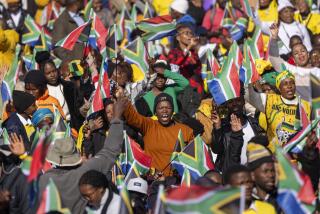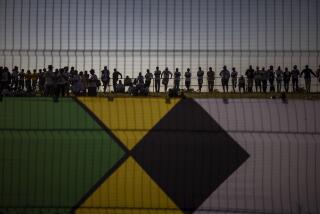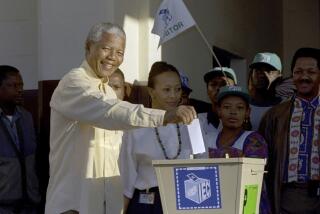National Agenda : Lesotho’s Throne: All in the Family : In a move to ensure stability, Moshoeshoe II is reinstated as king after abdication of son who replaced him.
- Share via
MASERU, Lesotho — The problem with the American flag had been spotted, and it was turned right side up. Cub Scouts sporting woolly loincloths and porcupine-quill headdresses had taken their places. The audience in Maseru’s soccer stadium was ready for a bizarre episode in the history of the small kingdom of Lesotho, high in the mountains of southern Africa: the abdication of a king in favor of his father.
The crowd was hushed as outgoing King Letsie III, 32, descended from a makeshift throne, signed away his crown with a flourish and took a seat at the back of the VIP pavilion. There, almost visibly relieved, he popped open a can of cola.
Then came the reinstatement of King Moshoeshoe II, 58 (pronounced mo-SHWAY-shway). A graduate of Britain’s Oxford University, gaunt and erect, he in an elegant black suit buttoned up to his neck. He vowed never again to meddle in politics, a habit that dethroned him once and exiled him twice from the mountainous country that likes to call itself the Roof of Africa.
As Moshoeshoe reascended the throne after an absence of more than four years, a wail of ululations came from women in an area reserved for the royal clan. But other parts of the stadium were quiet. The royal family might have no problem passing the crown around, but few among the Basutos, the people of the small, landlocked country, believed the transfer of power would end instability caused by the monarch’s long struggle with the left-wing elected government.
“Most of the people in my village stayed away. They don’t like King Moshoeshoe,” said 44-year-old farmer Patrick Ranyali, unemployed for two years and taking a break from scratching a bare subsistence from his mountain plot of maize and beans. “I’ve just come here to watch.”
Also on hand to witness the occasion was a collection of leaders from southern Africa, for whom the reinstatement of King Moshoeshoe was a symbol of the peaceful, democratic change they hope will become the norm in the area in the wake of the fall of white-minority rule in South Africa last year.
Presidents Robert Mugabe of Zimbabwe and Ketumile Masire of Botswana were there. The King of Swaziland sent his prime minister, splendidly decked out in an orange toga, with a red feather in his hair, and accompanied by a contingent of young warriors resplendent in leopard skins.
However, the most important actor in Lesotho’s drama has been South African President Nelson Mandela, who was in India but sent a representative to Maseru. Mandela played the key role in forcing Lesotho’s factions to compromise instead of fight.
Remote Lesotho had little choice, being completely surrounded by South Africa, the regional superpower. Political analysts believe the enforcement of a smooth transfer of power by a mix of diplomacy and military threats was the first sign of Mandela’s government acting as a visible force for good on the southern tip of the African continent.
“It’s an indication of how South African leaders could work together in the future. It’s one of the most positive things since the change in South Africa. In the past, Lesotho’s internal struggle would probably have resulted in military intervention,” said Greg Mills, director of research at South Africa’s Institute of International Affairs.
But a sense of goodwill in Lesotho only lasted as long as the pageantry of the Jan. 25 ceremony, which ended with Moshoeshoe being led away by an honor guard of horsemen on ponies bred by Lesotho’s homogeneous Basuto people.
All the soldiers wore traditional blankets over their shoulders and a variety of headgear, from conical Basuto hats to English riding helmets. The king wore leopard and antelope skins, brandished a club topped with a carving of a man’s head and kept chanting incantations until he was almost hoarse.
“Just think of it as traditional rap. We don’t understand a word of it either,” explained one of the plainclothes police officers around the perimeter.
But the policeman said he did not like the new king, even though it was his duty to take down posters some people had put up opposing the monarch’s reinstatement. Elements in the army, which has played an ambiguous role in recent events, also showed displeasure by painting out the initial “R” on a hill monument to the Royal Lesotho Defense Force that is visible from all over the capital.
Lesotho’s 2 million people face other problems in the new political landscape of southern Africa, obstacles that have led the few diplomats posted in Maseru to say that its outlook in the post-apartheid era is clouded and bleak.
Skepticism that the reinstated monarch will keep his vow of non-interference was barely concealed by Ntsu Mokhehle, 77, the frail prime minister and a veteran opponent of the king. He told the crowd that only outside guarantees had persuaded him to allow the king back on the throne. Both times Mokhehle’s left-wing party won elections, in 1970 and 1993, palace coups and machinations in the army kept it from exercising real power.
“The government has never been allowed to rule properly,” the prime minister said, finding shelter from a hot African sun under a green-and-white soccer club umbrella. “The government is under a lot of criticism from the general populace on this issue of reinstatement. . . . I expect no further attempts to subvert democracy.”
The economy faces difficulty and is largely dependent on South Africa. The former colony, called Basutoland under British rule, which ended in 1966, earns half of its national income from workers’ remittances earned in South African factories and mines.
Some academics talk of making Lesotho into South Africa’s 10th province. But, a South African Cabinet minister remarked, “it would just be a 10th set of problems. Nobody wants it.”
South Africa is struggling to find employment for its own people. Immigrant workers from neighboring states are not wanted and are being actively shooed out of townships and squatter camps.
Lesotho’s only solid hope for long-term economic viability is the ambitious Highlands water project, which may one day supply most of the kingdom with hydroelectric power and the heart of South Africa with water. Already, income from a first phase is helping to balance the government’s budget.
Nevertheless, southern Africa’s five-year drought has withered crops in Lesotho’s fields. A combination of erosion and sudden thunderstorms is carrying the topsoil away. Few farmers have even planted crops in the highlands this year, and the only vegetation that seems to be doing well is an extraordinary yellow-flowered shoot that climbs 30 feet high from the prickly leaves of the aloe cactus.
Tourists from South Africa and abroad, the country’s other hope, are few and far between. They had been warned to stay away during the past month’s instability. Up in the mountains at God Help Me Pass, a neatly kept pony-trekking center waited patiently for visitors who rarely came to sample the beauties of the mountain paths, unusual wildlife and waterfalls.
“Don’t ask me what’s going on in this country, because even we who live here don’t understand,” said a young professional from Maseru taking a day out on horseback. “My only ambition is to get a job in South Africa. Here, we never even know what’s going to happen tomorrow.”
More on Southern Africa
* Reprints of “Stability Spreading in Southern Africa,” a World Report Regional Outlook overview of the spread of democracy, are available from Times on Demand. Call 808-8463, press *8630 and select option 1. Order Item No. 6048. $2.
Details on Times electronic services, B4
More to Read
Sign up for Essential California
The most important California stories and recommendations in your inbox every morning.
You may occasionally receive promotional content from the Los Angeles Times.













